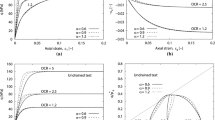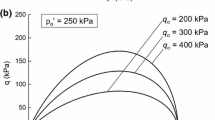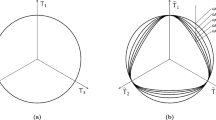Abstract
The paper presents a simple constitutive model for normally consolidated clay. A mathematical formulation, using a single tensor-valued function to define the incrementally nonlinear stress–strain relation, is proposed based on the basic concept of hypoplasticity. The structure of the tensor-valued function is determined in the light of the response envelope. Particular attention is paid towards incorporating the critical state and to the capability for capturing undrained behaviour of clayey soils. With five material parameters that can be determined easily from isotropic consolidation and triaxial compression tests, the model is shown to provide good predictions for the response of normally consolidated clay along various stress paths, including drained true triaxial tests and undrained shear tests.












Similar content being viewed by others
References
Bauer E (1996) Calibration of a comprehensive hypoplastic model for granular materials. Soils Found 36(1):13–26
Bauer E (2000) Conditions for embedding Casagrade’s critical states into hypoplasticity. Mech Cohes Frict Mater 5:125–148
Been K, Jefferies MG (1985) A state parameter for sands. Geotechnique 35(1):99–112
Butterfield R(1979) A natural compression law for soils. Geotechnique 29(4):469–480
Chambon R, Desrues J, Charlier R, Hammad W (1994). CLoE, a new rate type constitutive model for geomaterials: theoretical basis and implementation. Int J Numer Anal Methods Geomech 18(4):253–278
Gudehus G (1979) A comparison of some constitutive laws for soils under radially symmetric loading and unloading. In: Wittke (ed) Proceeds of the third international conference on numerical methods in geomechanics. A.A. Balkema, Aachen, pp 1309–1325.
Gudehus G (1996) A comprehensive constitutive equation for granular materials. Soils Found 36(1):1–12
Herle I, Kolymbas D (2004) Hypoplasticity for soils with low friction angles. Comput Geotech 31:365–373
Huang W (2000) Hypoplastic modelling of shear localization in granular materials. PhD Thesis, Graz University of Technology
Kolymbas D (2000) Introduction to hypoplasticity. A.A. Balkema, Rotterdam
Li XS, Dafalias YF (2000) Dilatancy for cohesionless soils. Geotechnique 50(4):449–460
Mašín D (2005) A hypoplastic constitutive model for clays. Int J Numer Anal Methods Geomech 29:311–336
Nakai T, Matsuoka H, Okuno N, Tsuzuki K (1986) True triaxial tests on normally consolidated clay and analysis of the observed shear behaviour using elastoplastic constitutive models. Soils Found 26(4):67–78
Nakai T, Hinokio M (2004) A simple elastoplastic model for normally and overconsolidated soils with unified materials parameters. Soils Found 44(2):53–70
Niemunis A, Herle I (1997) Hypoplastic model for cohesionless soils with elastic strain range. Mech Cohes Frict Mater 2(4):279–299
Niemunis A (2003) Extended hypoplastic model for soils. Schreftenreihe des Institutes für Grundbau und Bodenmechanik der Ruhr-Universität Bochum, Heft 34, Bochum
Roscoe KH, Schofield AN, Wroth P (1958) On the yielding of soils. Geotechnique 8:22–52
Schofield A, Wroth P (1968) Critical state soil mechanics. Cambridge University Press, Cambridge
Tamagnini C, Viggiani G, Chambon R (2000) A review of two different approaches to hypoplasticity. In: Kolymbas D (ed) Constitutive modelling of granular materials. Springer, Berlin Heidelberg New York, pp 107–165
Truesdell C (1955) Hypoplasticity. J Ration Mech Anal 4:83–133
von Wolffersdorff P-A (1996) A hypoplastic relation for granular materials with a predefined limit state surface. Mech Cohes Frict Mater 1:251–271
Wood DM (1990) Soil behaviour and critical state soil mechanics. Cambridge University Press, Cambridge
Wu W, Kolymbas D (1990) Numerical testing of the stability criterion for hypoplastic constitutive equations. Mech Mater 9:245–253
Wu W, Bauer E (1994) A simple hypoplastic constitutive model for sand. Int J Numer Anal Methods Geomech 18:833–862
Wu W, Niemunis A (1996) Failure criterion, flow rule and dissipation function derived from hypoplasticity. Mech Cohes Frict Mater 1:145–163
Wu W, Kolymbas D (2000) Hypoplasticity then and now. In: Kolymbas D (ed) Constitutive modelling of granular materials. Springer, Berlin Heidelberg New York, pp 57–105
Yao YP, Sun DA, Luo T (2004) A critical state model for sands dependent on stress and density. Int J Numer Anal Methods Geomech 28:323–337
Yu HS (1998) CASM: a unified state parameter model for clay and sand. Int J Numer Anal Methods Geomech 22:621–653
Acknowledgement
The financial support of Australian Research Council (grant DP0453056) is gratefully acknowledged by the first author.
Author information
Authors and Affiliations
Corresponding author
Appendix
Appendix
Here we present a brief description of the hypoplastic model proposed by Mašín [12]. The constitutive equation is
Here the fourth order tensor L takes the form
and the second order tensor N is given as
with m being defined by
In these equations, the parameters a and F are related to the critical friction angle φc and the Lode angle θ through the relation [21]
with \(\tan \psi = {\sqrt 3 }|\hat{\varvec{\sigma} }_{\rm d} \,|.\) The parameter Y in expression for N, known as the degree of nonlinearity [16], has the following form:
where I 1, I 2 and I 3 are the first, second and third stress invariants, respectively:
The factors f s and f d in Eq. 29 are defined by
where the scalar parameter α can be determined from
The factors c 1 and c 2 in above equation are related to other parameters via
The model contains five parameters: φc, λ*, κ*, r and N *, where φc is the critical state friction angle, λ* and κ* has the same meaning as in Eq.10a, b, r is the ratio of the bulk modulus over the shear modulus at an isotropic stress state, r=K + i /G i , and N * represents the logarithmic specific volume at a mean pressure of 1 kPa so that N *=ln (1+e) |p=1 kPa.
Rights and permissions
About this article
Cite this article
Huang, WX., Wu, W., Sun, DA. et al. A simple hypoplastic model for normally consolidated clay. Acta Geotech. 1, 15–27 (2006). https://doi.org/10.1007/s11440-005-0003-3
Received:
Accepted:
Published:
Issue Date:
DOI: https://doi.org/10.1007/s11440-005-0003-3




